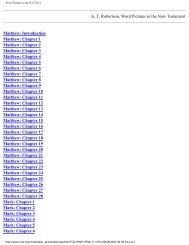Commentary on Joshua - Keil & Delitzsch - David Cox
Commentary on Joshua - Keil & Delitzsch - David Cox
Commentary on Joshua - Keil & Delitzsch - David Cox
You also want an ePaper? Increase the reach of your titles
YUMPU automatically turns print PDFs into web optimized ePapers that Google loves.
<strong>Keil</strong> and <strong>Delitzsch</strong> <str<strong>on</strong>g>Commentary</str<strong>on</strong>g> <strong>on</strong> the Old Testament<br />
Zanute , the last inhabited place up<strong>on</strong> the mountains, five hours from Hebr<strong>on</strong>,<br />
between Shuweikeh and Attir (see Rob. ii. p. 626; Seetzen , iii. p. 27, 29). Kirjathsannah<br />
, or Debir , has not been traced (see at Josh 10:38).<br />
Verse 50. Anab , <strong>on</strong> the north-east of Socoh (see at Josh 11:21). Eshtemoh , or<br />
Eshtemoa , which was ceded to the priests (Josh 21:14; 1 Chr<strong>on</strong> 6:42), and is<br />
menti<strong>on</strong>ed again in 1 Sam 30:28; 1 Chr<strong>on</strong> 4:17,19, is the present Semua , an inhabited<br />
village, with remains of walls, and a castle of ancient date, <strong>on</strong> the east of Socoh (<br />
Rob. ii. pp. 194, 626; Seetzen , iii. 28; and v. Schubert , R. ii. p. 458). Anim ,<br />
c<strong>on</strong>tracted, according to the probable c<strong>on</strong>jecture of Wils<strong>on</strong> , from Ayanim (fountains),<br />
a place still preserved in the ruins of the village of el Ghuwein , <strong>on</strong> the south of<br />
Semua , though Robins<strong>on</strong> err<strong>on</strong>eously c<strong>on</strong>nects it with Ain (v. 32: see Rob. Pal. ii. p.<br />
626).<br />
Verse 51. Goshen, Hol<strong>on</strong> , and Giloh , are still unknown. On Goshen , see at Josh<br />
10:41. Hol<strong>on</strong> was given up to the priests (Josh 21:15; 1 Chr<strong>on</strong> 6:43); and Giloh is<br />
menti<strong>on</strong>ed in 2 Sam 15:12 as the birth-place of Ahithophel.<br />
Verse 52-54. The sec<strong>on</strong>d group of nine towns, to the north of the former, in the<br />
country round Hebr<strong>on</strong>.<br />
Verse 52. Arab is still unknown; for we cannot c<strong>on</strong>nect it, as Knobel does, with the<br />
ruins of Husn el Ghurab in the neighbourhood of Semua ( Rob. i. p. 312), as these<br />
ruins lie within the former group of towns. Duma , according to Eusebius the largest<br />
place in the Daromas in his time, and seventeen miles from Eleutheropolis, is<br />
probably the ruined village of Daumeh , by the Wady Dilbeh ( Rob. i. p. 314), which<br />
is fourteen miles in a straight line to the south-east of Eleutheropolis according to the<br />
map. Es'an (Eshean) can hardly be identified with Asan (1 Chr<strong>on</strong> 4:32), as Van de<br />
Velde supposes, but is more likely Korasan (1 Sam 30:30). In that case we might<br />
c<strong>on</strong>nect it with the ruins of Khursah , <strong>on</strong> the north-west of Daumeh, two hours and a<br />
half to the south-west of Hebr<strong>on</strong> ( Rob. iii. p. 5). As the Septuagint reading is Doma' ,<br />
Knobel c<strong>on</strong>jectures that Eshean is a corrupt reading for Shema (1 Chr<strong>on</strong> 2:43), and<br />
http://207.44.232.113/~bible/comment/ot/k&d/josh/jos100.html (2 of 3) [13/08/2004 01:18:45 p.m.]
















